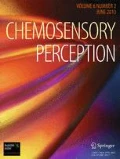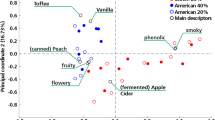Abstract
Aim
The complex aromas of cocktails provide a unique and interesting model system to evaluate the effects of alcohol matrix and aroma-aroma interactions on human aroma perception and partitioning and release of aroma compounds. Here, we study the interactions that occur in an Old-Fashioned cocktail when different types of whiskeys are mixed with different styles of bitters.
Methods
The interactions are studied in two ways, namely, by sensory descriptive analysis to evaluate changes in human aroma perception, and by headspace solid-phase microextraction and gas chromatography-mass spectrometry to study the volatile profiles individually and upon mixing.
Results
Several aroma descriptors showed significant additive and suppressing interaction effects between bitters and whiskeys, and unique sensory characteristics were introduced by both bitters and whiskeys. Volatile compounds also showed suppressing and enhancing effects upon mixing of bitters with whiskeys.
Conclusions
Such behaviors point towards chemical mixture effects and the enhancements in two compounds cannot be attributed to just the addition of certain bitters as the effects differ among the four whiskeys.
Implications
These interactive sensory effects suggest further questions of interest about the inherent sensory complexity of foods and beverages; if sensory qualities in even simple cocktails, such as an Old-Fashioned, only exist upon mixing and for specific combinations of bitters and whiskeys, further unique interactions could be envisioned for more complex mixtures.




Similar content being viewed by others
Notes
Some cocktails called “Old-Fashioneds” are permutations containing fruit, seltzer, or soda, but for the purposes of this experiment, we are concerned with the simplest possible definition of the cocktail.
References
Acree TE, Arn H (2004) Flavornet and human odor space gas chromatography-olfactometry (GCO) of natural products. http://www.flavornet.org. Accessed 16 May 2016
Buglass AJ (2011) Handbook of alcoholic beverages: technical, analytical and nutritional aspects. Wiley, West Sussex
Clarke P (2010) Bittersweet symphony. Imbibe magazine. Imbibe Media Inc., Portland
El-Sayed AM (2011) The pherobase: database of pheromones and semiochemicals. http://www.pherobase.com. Accessed 16 May 2016
Gay C (1998) Invitation to comment. Food Qual Prefer 9:166. doi:10.1016/S0950-3293(97)00052-9
Grimes W (2002) Straight up or on the rocks: the story of the American cocktail. North Point Press, New York
Haigh T (2009) Vintage spirits and forgotten cocktails: from the Alamagoozlum to the zombie 100 rediscovered recipes and the stories behind them. Quarry Books, Beverly
Hellmich M (2006) The ultimate bar book: the comprehensive guide to over 1,000 cocktails. Chronicle Books, San Francisco
Heymann H, Ebeler SE (2017) Case Study 8 - Projective mapping (PM) of gins from the United Kingdom, the United States of America, France, and Germany. In: Sensory and Instrumental Evaluation of Alcoholic Beverages (Heymann H., Ebeler S.E., eds.), Elsevier, p. 216-223. doi:10.1016/B978-0-12-802727-1.00014-4
Hopfer H, Ebeler SE, Heymann H (2012) How blending affects the sensory and chemical properties of red wine. Am J Enol Vitic 63:313–324. doi:10.5344/ajev.2012.11112
International Organization for Standardization (1977) ISO 3591: Sensory analysis - apparatus - wine tasting glass
Johnson AJ, Heymann H, Ebeler SE (2015) Volatile and sensory profiling of cocktail bitters. Food Chem 179:343–354. doi:10.1016/j.foodchem.2015.01.114
Kováts E (1958) Gas-chromatographische Charakterisierung organischer Verbindungen. Teil 1: Retentionsindices aliphatischer Halogenide, Alkohole, Aldehyde und Ketone. Helv Chim Acta 41:1915–1932. doi:10.1002/hlca.19580410703
Lawless HT, Heymann H (2010) Sensory evaluation of food: principles and practices. Springer, New York
Lê S, Husson F (2008) Sensominer: a package for sensory data analysis. J Sens Stud 23:14–25. doi:10.1111/j.1745-459X.2007.00137.x
Ledauphin J, Saint-Clair J-F, Lablanquie O et al (2004) Identification of trace volatile compounds in freshly distilled calvados and cognac using preparative separations coupled with gas chromatography−mass spectrometry. J Agric Food Chem 52:5124–5134. doi:10.1021/jf040052y
Li H, Tao Y-S, Wang H, Zhang L (2008) Impact odorants of chardonnay dry white wine from Changli County (China). Eur Food Res Technol 227:287–292. doi:10.1007/s00217-007-0722-9
Luebke W (2014a) Estragole. In: Perflavory inf. syst. http://www.perflavory.com/docs/doc1013251.html. Accessed 10 Jan 2016
Luebke W (2014b) (E)-anethol. In: Perflavory inf. syst. http://www.perflavory.com/docs/doc1001151.html. Accessed 10 Jan 2016
Luebke W (2014c) Myristicin. In: Perflavory inf. syst. http://www.perflavory.com/docs/doc1104961.html. Accessed 10 Jan 2016
Luebke W (2014d) Carvone. In: Perflavory inf. syst. http://www.perflavory.com/docs/doc1399011.html. Accessed 10 Jan 2016
Luebke W (2014e) 2-Tridecanone. In: Perflavory inf. syst. http://www.perflavory.com/docs/doc1029481.html. Accessed 10 Jan 2016
Maclean C (2007) Whisky Tales. Little Books, St. Albans
de Mendiburu F (2013) agricolae: Statistical procedures for agricultural research. http://cran.r-project.org/package=agricolae. Accessed 20 June 2016
Mevik B-H, Wehrens R (2007) The pls package: principal component and partial least squares regression in R. J Stat Softw 18:1–24. doi:10.18637/jss.v018.i02
National Institute of Standards and Technology (2008) The NIST 08 Mass Spectral Library. Gaithersburg, MD, USA
Parsons BT, Anderson E (2011) Bitters: a spirited history of a classic cure-all, with cocktails, recipes, and formulas. Ten Speed Press, Berkeley
R Core Team (2013) R: A language and environment for statistical computing. Vienna, Austria. ISBN 3–900051–07-0, URL http://www.R-project.org
Regan G (2003) The joy of mixology: the consummate guide to the bartender’s craft. Clarkson N Potter Publishing, New York
Sampson E, Chittenden G, Croswell H (1806) The balance and Columbian repository: volume 5. Sampson, Chittenden & Croswell, Hudson
Simonson R, Krieger D (2014) The old-fashioned the story of the world’s first classic cocktail, with recipes and Lore. Ten Speed Press, Berkeley
Stewart A (2013) The Drunken Botanist. Algonquin Books of Chapel Hill, Chapel Hill
Swiegers JH, Bartowsky EJ, Henschke PA, Pretorius IS (2005) Yeast and bacterial modulation of wine aroma and flavour. Aust J Grape Wine Res 11:139–173. doi:10.1111/j.1755-0238.2005.tb00285.x
Tonutti I, Liddle P (2010) Aromatic plants in alcoholic beverages. A review. Flavour Fragr J 25:341–350. doi:10.1002/ffj.2001
Van den Dool H, Kratz PD (1963) A generalization of the retention index system including linear temperature programmed gas-liquid partition chromatography. J Chromatogr 11:463–471. doi:10.1016/S0021-9673(01)80947-X
Vianna E, Ebeler SE (2001) Monitoring ester formation in grape juice fermentations using solid phase microextraction coupled with gas chromatography-mass spectrometry. J Agric Food Chem 49:589–595. doi:10.1021/jf000907g
Wondrich D, DeGroff D (2007) Imbibe!: from absinthe cocktail to whiskey smash, a salute in stories and drinks to “professor” Jerry Thomas, Pioneer of the American bar featuring the original formulae. Imbibe Media Inc., Portland
Acknowledgments
The authors thank all participants of the descriptive analysis for their participation and contribution. Financial support for AJJ was partially provided by a National Science Foundation Graduate Research Fellowship (DGE-1148897). No additional external funding was received for this study.
Author information
Authors and Affiliations
Corresponding author
Ethics declarations
Funding
Financial support for AJJ was partially provided by an NSF Graduate Research Fellowship Grant number DGE-1148897. No additional external funding was received for this study.
Conflict of Interest
Authors Johnson and Heymann declare no conflict of interest. Susan E. Ebeler is the Co-Director and Helene Hopfer was the Research Director of the Food Safety and Measurement Facility at UC Davis, which is supported by loans and donations from Agilent Technologies, Inc., Constellation Brands, US, and Gerstel US, Inc. None of the organizations listed were involved in study conception, design or interpretation, or the decision to publish these data.
Ethical Approval
All procedures performed in studies involving human participants were in accordance with the ethical standards of the institutional and/or national research committee and with the 1964 Helsinki declaration and its later amendments or comparable ethical standards. The Institutional Review Board (IRB) at UC Davis reviewed the study and declared it exempt (protocol 351687-1). Panelists gave oral consent.
Electronic Supplementary Material
ESM 1
(PDF 3024 kb)
Rights and permissions
About this article
Cite this article
Johnson, A.J., Hopfer, H., Heymann, H. et al. Aroma Perception and Chemistry of Bitters in Whiskey Matrices: Modeling the Old-Fashioned. Chem. Percept. 10, 135–148 (2017). https://doi.org/10.1007/s12078-017-9229-3
Received:
Accepted:
Published:
Issue Date:
DOI: https://doi.org/10.1007/s12078-017-9229-3




